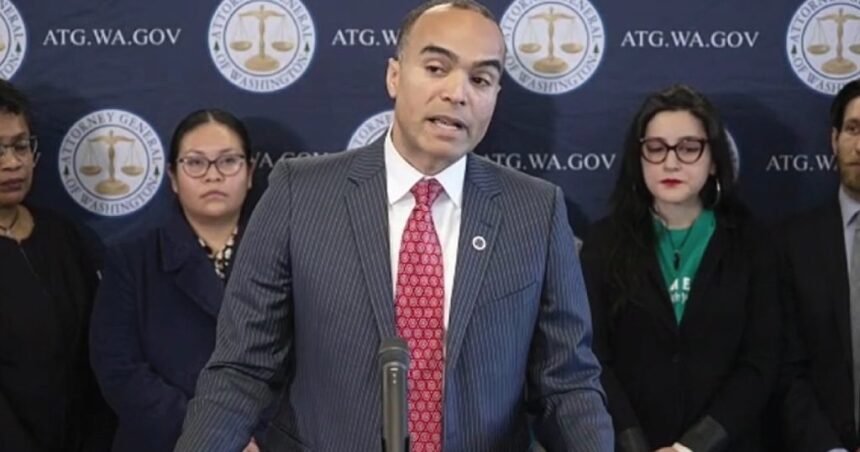The United States has long upheld the principle of birthright citizenship, a cornerstone of the nation’s identity as a melting pot of cultures and communities. Enshrined in the 14th Amendment of the U.S. Constitution, this right has sparked debates and controversies for decades. However, the stakes were raised dramatically when former President Donald Trump, mere hours into his new term, signed an executive order aimed at ending this constitutional guarantee.
In a historic response, 22 state attorneys general swiftly filed a lawsuit challenging this move, underscoring the political and legal battle to preserve a fundamental tenet of American democracy. This article delves into the lawsuit, its constitutional underpinnings, and the broader implications of the case.
The Controversial Executive Order
On the first day of his presidency, Trump signed a slew of executive orders, including one targeting birthright citizenship. This directive sought to redefine who qualifies as a U.S. citizen, aiming to exclude children born to non-citizen parents on American soil. Trump’s order relied on an interpretation of the 14th Amendment that deviates sharply from its established understanding, prompting a strong backlash.
The 14th Amendment, ratified in 1868, unequivocally states:
“All persons born or naturalized in the United States, and subject to the jurisdiction thereof, are citizens of the United States and of the state wherein they reside.”
This language has been upheld by Supreme Court decisions and legal precedents for over a century. However, Trump’s executive order argued that children born to undocumented immigrants or non-citizens do not fall under the jurisdiction of U.S. law, a claim widely criticized as unconstitutional.
The Coalition of 22 States: United for Constitutional Integrity
In response to this executive order, 22 states joined forces to file a lawsuit aimed at blocking its implementation. This coalition includes a diverse group of states such as California, Wisconsin, Colorado, Maryland, and Hawaii. Their primary argument is rooted in the Constitution: no executive order can override the explicit language of the 14th Amendment.
Attorney General Josh Kaul of Wisconsin, a key figure in the lawsuit, remarked:
“The U.S. Constitution is clear: if you are born in this country and subject to its jurisdiction, you are a citizen. No president has the authority to erase that with the stroke of a pen.”
Kaul’s sentiment reflects the broader consensus among the coalition, which asserts that the executive order represents an egregious abuse of presidential power and a violation of constitutional principles.
Legal Grounds for the Lawsuit
The lawsuit is built on several legal pillars:
- Violation of the 14th Amendment:
The primary argument is that the executive order directly contradicts the plain language of the Constitution. Any change to the 14th Amendment would require a constitutional amendment, not an executive action. - Federal Precedent:
The U.S. Supreme Court has previously upheld the principle of birthright citizenship in landmark cases such as United States v. Wong Kim Ark (1898), where it was established that children born on U.S. soil to non-citizen parents are citizens. - Separation of Powers:
The lawsuit contends that Trump’s executive order oversteps the boundaries of executive authority, infringing upon powers reserved for Congress and the judiciary. - Impact on Children’s Rights:
The order could strip millions of children of their citizenship, creating a class of stateless individuals with no legal rights or protections in any country.
Political and Legal Implications
This case highlights the growing tension between the executive branch and the judiciary over constitutional interpretation. While the coalition of states remains optimistic, the current composition of the U.S. Supreme Court, with its conservative majority, raises questions about the outcome.
Attorney General Kaul expressed cautious optimism:
“When the Constitution, federal law, and precedent are on your side, you have a strong case. However, we must remain vigilant given the shifting dynamics of the judiciary.”
The case also sets a precedent for future challenges to executive overreach. If Trump’s order is upheld, it could open the door to further attempts to bypass constitutional safeguards through executive actions.
A Broader Debate: Immigration and Identity
At its core, this legal battle is about more than just birthright citizenship—it’s about America’s identity as a nation of immigrants. Critics argue that Trump’s executive order is part of a broader strategy to curtail immigration and redefine who belongs in the United States.
Supporters of the order, however, claim it is a necessary step to address issues such as illegal immigration and the burden on public resources. This divide reflects the ongoing debate over immigration policy in the U.S., with both sides using the courts to advance their agendas.
The Road Ahead
As the case progresses, legal experts predict it will ultimately reach the U.S. Supreme Court, where its fate will be decided. The stakes are high, as the ruling could have far-reaching implications for millions of Americans and the integrity of the Constitution itself.
This lawsuit also underscores the importance of state-level leadership in holding the federal government accountable. By joining forces, the 22 states have demonstrated the power of collective action in defending constitutional rights.
———————————————
The lawsuit against Trump’s executive order to end birthright citizenship is a pivotal moment in American legal history. It challenges not only the scope of presidential authority but also the nation’s commitment to its founding principles.
As this case unfolds, it serves as a reminder that the Constitution is more than just a document—it is a promise to uphold the rights and freedoms of every individual born on American soil.







